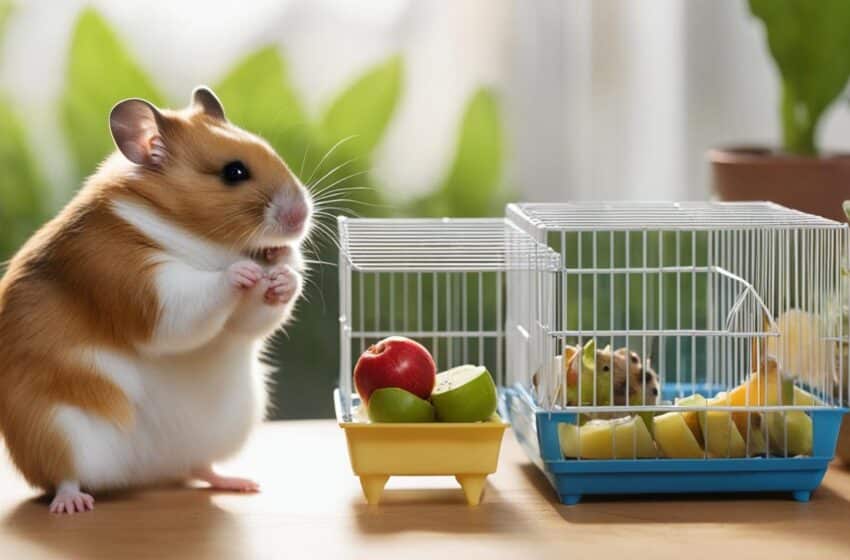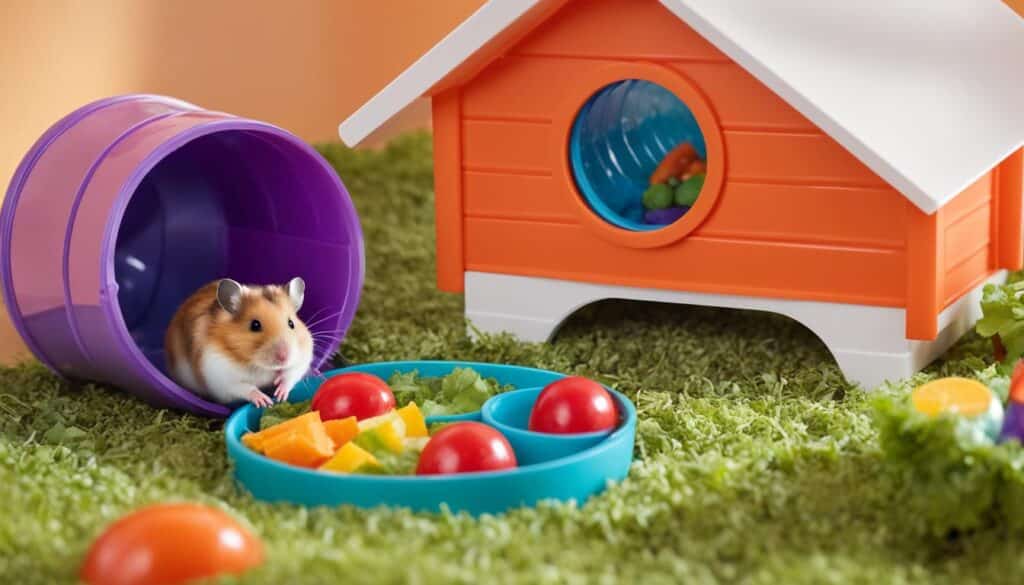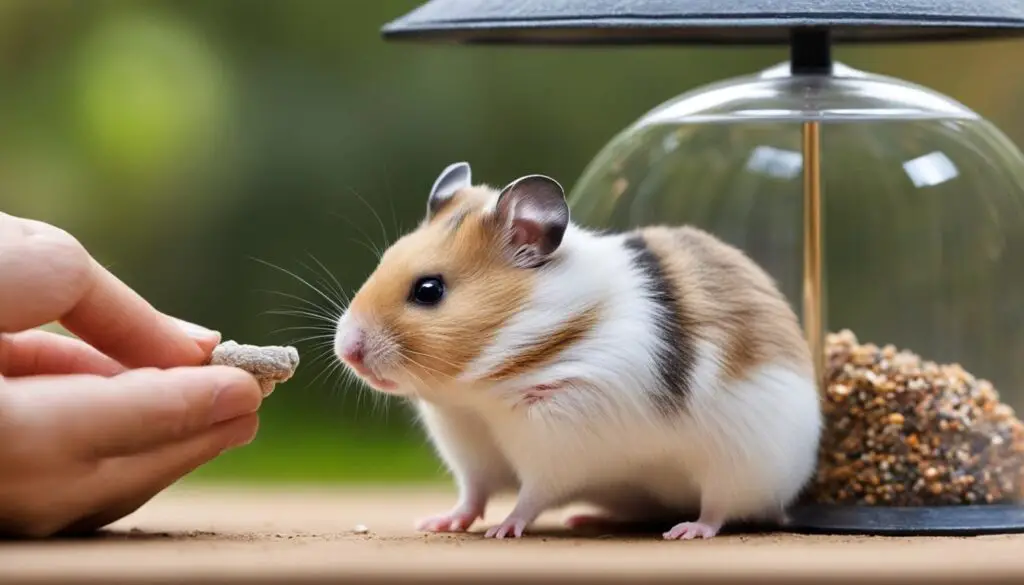Building a Bond: Tips for Getting Closer to Your Hamster

Building a strong bond with your hamster is an incredibly rewarding experience. It allows you to develop a deeper connection and understanding of your furry friend. By following these tips, you can create a loving and trusting relationship with your pet hamster.
Key Takeaways:
- Spending quality time with your hamster is crucial for building a bond.
- Understanding your hamster’s behavior and needs helps create a safe and stimulating environment.
- Setting up a comfortable living space with a spacious cage and cozy hiding spots is essential.
- Bonding through food and treats can establish trust and positive associations.
- Gentle handling and socializing with your hamster gradually builds trust and strengthens the bond.
Understanding Your Hamster’s Behavior and Needs
Building a bond with your hamster requires a deep understanding of their behavior and meeting their basic needs. Hamsters are social and curious animals, and providing a safe and stimulating environment for them is essential for their overall well-being.
A spacious cage is necessary to allow your hamster to move around freely. It should provide ample space for them to exercise, play, and explore. Additionally, ensure that the cage has secure bars and a solid base to prevent any potential escapes or injuries.
Hamsters also have specific dietary requirements that need to be met for them to thrive. A balanced and nutritious diet rich in fresh fruits, vegetables, and high-quality hamster pellets is crucial. Avoid feeding them sugary or foods that are toxic to them, such as chocolate or onions.
Creating opportunities for play and exploration is equally important. Hamsters are natural burrowers, so providing plenty of bedding materials, tunnels, and hideouts will allow them to engage in their instinctive behaviors. Offering a variety of hamster-friendly toys and accessories will keep them mentally stimulated and prevent boredom.
“To build a bond with your hamster, you must create an environment that caters to their natural instincts and provides for their physical and mental needs.” – Hamster Expert
It’s important to note that hamsters are primarily nocturnal animals, meaning they are most active at night. Therefore, it’s crucial to provide them with a quiet and undisturbed resting place during the day, ensuring they get adequate sleep.
Understanding your hamster’s behavior will help you recognize signs of discomfort, stress, or illness. Watch for any changes in appetite, activity levels, or social behavior, and seek veterinary attention if necessary.
By providing a safe, stimulating, and nurturing environment, you can ensure your hamster’s well-being and strengthen the bond between you and your furry friend.
Hamster Behavior Cheat Sheet
| Behavior | Meaning |
|---|---|
| Teeth chattering | Sign of aggression or warning |
| Running on a wheel | Exercise and releasing energy |
| Grooming | Indicates relaxation and self-care |
| Burrowing | Comfort-seeking behavior |
| Whiskers twitching | Alertness and assessing the environment |
| Tail wagging | Excitement or happiness |
Creating a Comfortable Living Space for Your Hamster
Providing a cozy and secure environment is crucial for your hamster’s well-being. A proper hamster cage setup allows them to thrive and live a happy, healthy life. Here are some tips to create a comfortable habitat for your furry friend.
1. Spacious Cage
Choose a cage that offers plenty of room for your hamster to move around. A larger habitat allows them to exercise and explore. Look for cages with multiple levels or add-ons to provide variety and stimulation.
2. Cozy Sleeping Areas
Hamsters love to burrow and create cozy nests. Include soft bedding materials, such as shredded paper or aspen shavings. Provide hiding spots, such as tunnels or small houses, where your hamster can retreat for privacy and rest.
3. Hamster-Friendly Toys and Accessories
Keeping your hamster mentally stimulated is essential. Include a variety of toys, such as chew toys, exercise wheels, and tunnels. These enriching activities help prevent boredom and encourage natural behaviors.
4. Safe and Comfortable Substrate
Choose a substrate that is safe and comfortable for your hamster. Avoid cedar shavings, as the scent can be harmful to their respiratory system. Instead, opt for aspen shavings or paper-based bedding.
5. Proper Ventilation
Ensure your hamster’s cage has proper ventilation to maintain a clean and odor-free environment. Good airflow helps prevent the buildup of ammonia and reduces the risk of respiratory issues.
| Key Elements for a Cozy Hamster Habitat | Recommended Choices |
|---|---|
| Spacious Cage | A wire or glass tank with multiple levels |
| Cozy Sleeping Areas | Soft bedding materials like shredded paper or aspen shavings |
| Hamster-Friendly Toys and Accessories | Chew toys, exercise wheels, tunnels |
| Safe and Comfortable Substrate | Aspen shavings or paper-based bedding |
| Proper Ventilation | Adequate airflow in the cage |
By creating a cozy and stimulating environment, you are providing your hamster with the perfect habitat to thrive. Remember to regularly clean the cage, provide fresh food and water, and spend quality time bonding with your furry friend.

Bonding Through Food and Treats
Food can be a powerful tool for bonding with your hamster. By offering treats and hand-feeding, you can establish trust and create positive associations. It’s essential to provide a balanced and nutritious diet that meets your hamster’s dietary needs.
Feeding your hamster treats is not only a delicious way to reward good behavior, but it also helps strengthen your bond. When offering treats, make sure to use appropriate portion sizes and choose treats that are safe for hamsters. It’s best to avoid treats high in sugar, salt, or artificial ingredients, as these can be harmful to their health.
Hand-feeding your hamster is a great way to interact with them and establish a personal connection. Start by offering small pieces of their regular food from your hand. As your hamster becomes more comfortable, you can gradually introduce different treats, such as fresh fruits and vegetables, specially formulated hamster treats, or even small portions of cooked lean meat.
When hand-feeding your hamster, remember to approach them calmly and let them come to you. For some hamsters, it may take time for them to trust your hand near their food. Be patient and allow them to feel safe and comfortable during this bonding activity.
The act of feeding your hamster not only fulfills their nutritional needs but also encourages them to associate your presence with positive experiences. It helps create a sense of security and reinforces the bond between you and your furry friend.
Feeding Tips for Bonding:
- Offer treats in moderation and as rewards for good behavior.
- Choose treats that are safe and appropriate for hamsters.
- Avoid treats high in sugar, salt, or artificial ingredients.
- Hand-feed small pieces of their regular food to establish trust.
- Introduce a variety of treats, such as fresh fruits and vegetables.
- Ensure treats are small and easy for your hamster to eat.
- Allow your hamster to approach and take the treat from your hand.
“Hand-feeding your hamster is not only a bonding activity but also a way to ensure that they receive nutrients and experience positive associations with you.”
In addition to bonding through treats, it’s crucial to provide a balanced diet for your hamster’s overall health. Hamsters have specific nutritional requirements, and offering a well-rounded diet is essential for their well-being.
| Essential Nutrients for Hamsters: | Sources |
|---|---|
| Protein | Hamster pellets, seeds, insects, cooked lean meat |
| Fiber | Hay, fresh vegetables, and fruits, high-quality hamster food |
| Vitamins and Minerals | Fresh vegetables, fruits, and specialized hamster food |
| Water | Clean, fresh water should always be available in a water bottle or dish |
Providing a well-balanced diet that includes these essential nutrients will help support your hamster’s overall health and well-being. Always consult with your veterinarian for specific dietary recommendations based on your hamster’s breed, age, and individual needs.
Handling and Socializing with Your Hamster
To build a strong bond with your hamster, it’s important to handle and socialize with them regularly. Handling your hamster gently and respectfully is key to helping them become more comfortable with human interaction.
Getting Started with Handling
When you first start handling your hamster, it’s crucial to take things slow and be patient. Begin with short handling sessions, around 5-10 minutes, to allow your hamster to adjust to being touched and held. Gradually increase the duration of the sessions as your hamster becomes more at ease.
Before picking up your hamster, make sure to wash your hands to remove any scents that may be unfamiliar to them. This will help prevent any potential stress or discomfort for your pet. Approach your hamster calmly and gently, allowing them to smell your hand before attempting to pick them up.
Remember, it’s important to respect your hamster’s boundaries. If they show signs of stress or discomfort, such as biting or squeaking, it’s best to give them some space and try again later. Each hamster has its own unique personality and may require different amounts of handling and socialization.
Socializing and Quality Time
Socializing with your hamster goes beyond simple handling. Spending quality time together can involve activities such as playing, offering treats, and engaging them in interactive toys. This not only provides mental stimulation but also helps build trust and strengthen your bond.
Here are a few socializing activities you can try with your hamster:
- Provide a safe and secure play area outside of their cage where your hamster can explore under supervision. This allows them to experience new sights, smells, and textures while still feeling protected.
- Purchase or make interactive toys that encourage your hamster’s natural instincts to climb, chew, and forage. These toys provide mental stimulation and help keep your hamster active and entertained.
- Offer treats during socialization sessions to create positive associations. Hand-feed your hamster treats like small pieces of fresh vegetables or hamster-friendly snacks. This can help establish trust and reinforce the bond between you and your pet.
Remember, every hamster is unique, and some may be more sociable than others. Be patient and understanding as you spend time getting to know your furry friend. Over time, your hamster will become more comfortable and eager to engage in social activities with you.
By handling your hamster with care and spending quality time socializing with them, you can build trust, strengthen your bond, and create a rewarding and loving relationship with your beloved pet.
| Benefits of Handling and Socializing with Your Hamster | Tips for Effective Socialization |
|---|---|
|
|
Understanding Hamster Body Language
Learning to interpret your hamster’s body language is crucial for understanding their emotions and needs. By observing their posture, facial expressions, and vocalizations, you can effectively communicate with your hamster and strengthen your bond.
Signs of Happiness
- A relaxed body posture with a slightly arched back
- Curious and alert behavior
- Light, rapid grooming
- Playfulness, such as hopping or running on their wheel
Signs of Stress
- Excessive or aggressive grooming
- Repeatedly scratching or biting themselves
- Abnormal vocalizations, such as squeaking or hissing
- Attempts to escape or hide
Signs of Fear or Discomfort
- Freezing in place or crouching low to the ground
- Flattened ears and wide-eyed expression
- Backing away or hiding in their bedding
- Excessive trembling or shaking
Remember that each hamster may display slightly different body language cues. It’s important to observe your individual hamster and learn their specific behaviors and preferences.
Interpreting hamster body language is a skill that develops over time. By paying attention to their non-verbal communication and responding appropriately, you can ensure their happiness and well-being.
Continue reading to discover the importance of patience and consistency in bonding with your hamster in Section 7.
Patience and Consistency in Bonding
Bonding with your hamster requires time, patience, and understanding. Each hamster has a unique personality and may respond differently to various bonding techniques. By being patient and consistent in your interactions, you can build a lasting bond with your furry friend.
Consistency is key when it comes to bonding with your hamster. Establishing a routine and spending regular, quality time together will help your hamster feel secure and comfortable in your presence. Whether it’s feeding, handling, or playing, maintaining a consistent schedule of interaction will foster trust and deepen your bond.
Positive reinforcement plays a vital role in building a lasting bond with your hamster. Rewarding good behavior with treats or praise can reinforce the connection between you and your pet. Celebrate milestones and small achievements, and be patient if progress is slow. Remember, each hamster has their own pace when it comes to bonding.
Understanding your hamster’s body language is crucial for providing the right level of interaction and ensuring their comfort. Pay attention to their cues and adjust your approach accordingly. If your hamster seems stressed or overwhelmed, give them space and try again later. Building a lasting bond is a journey that requires patience, adaptability, and respect for your hamster’s needs.
Key Points:
- Bonding with your hamster takes time and patience.
- Be consistent in your interactions and provide a routine.
- Offer positive reinforcement to reinforce the bond.
- Understand your hamster’s body language and adjust your approach accordingly.

Expert Quote:
“Building a lasting bond with your hamster requires patience, consistency, and understanding. By providing a consistent routine and offering positive reinforcement, you can create a strong and trusting relationship with your furry friend.” – Dr. Sarah Peterson, Veterinarian
Conclusion
Bonding with your hamster is a process that requires time, effort, and understanding. By following these tips and strategies, you can build a strong bond and create a rewarding relationship with your furry companion.
To foster a deep connection with your hamster, it’s important to be patient. Each hamster has a unique personality and may take time to feel comfortable and trust you. Show love and care by providing a safe and stimulating environment. Ensure their cage is spacious and filled with cozy areas for them to sleep and hide.
Consistency is key in building a bond with your hamster. Make sure to interact with them regularly, offering treats and hand-feeding to establish trust. Handling your hamster gently and respecting their boundaries will help them feel more comfortable with human interaction.
Remember, building a strong bond with your hamster is a rewarding journey. By being patient, consistent, and providing love and care, you can create a lasting and fulfilling relationship with your furry friend.
FAQ
How can I build a bond with my hamster?
To build a bond with your hamster, it is crucial to understand their behavior and meet their basic needs. Provide a spacious cage, appropriate diet, and opportunities for play and exploration. Spend quality time handling, socializing, and playing with your hamster.
What should I consider when setting up a living space for my hamster?
To create a comfortable living space for your hamster, ensure the cage is spacious with cozy areas for sleeping and hiding. Include hamster-friendly toys and accessories for mental stimulation. Provide a safe and secure environment.
How can food help in bonding with my hamster?
Utilize food as a bonding tool by offering treats and hand-feeding your hamster. This establishes trust and creates positive associations. Ensure a balanced and nutritious diet that meets your hamster’s dietary needs.
How can I handle and socialize with my hamster?
Handle your hamster gently and regularly, starting with short, gentle sessions and gradually increasing the duration over time. Let your hamster come to you and respect their boundaries. Spend quality time socializing and playing with your hamster.
How can I understand my hamster’s body language?
Learning to interpret your hamster’s body language is crucial for understanding their emotions and needs. Observe their posture, facial expressions, and vocalizations to gauge happiness, stress, fear, or discomfort. Respond accordingly to effectively communicate and strengthen your bond.
What is important in bonding with my hamster?
Bonding with your hamster takes time and patience. Each hamster has a unique personality and may require different approaches. Be consistent in your interactions, provide a routine, and offer positive reinforcement. Be patient and understanding to build a lasting bond.
How do I build a bond with my hamster?
Bonding with your hamster is a process that requires time, effort, and understanding. Follow these tips and strategies to build a strong bond and create a rewarding relationship with your furry companion. Be patient, provide a safe and stimulating environment, and show love and care to foster a deep connection.



